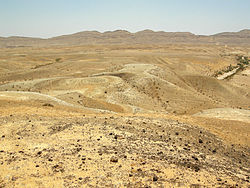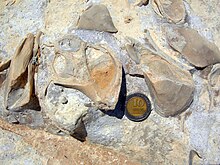Jurassic: Difference between revisions
boldness |
boldness |
||
| Line 83: | Line 83: | ||
== Flora == |
== Flora == |
||
YOOOOOOOOOOOOOOOOOOOOOOOOOOOOOOOOOOOOOOOOOOOOOOOOOOOOOOOOOOOOOOOOOOOOOOOOOOOOOOOOOOOOOOOOOOOOOOOOOOOOOO Extant conifer families that flourished during the Jurassic included the [[Araucariaceae]], [[Cephalotaxaceae]], [[Pinaceae]], [[Podocarpaceae]], [[Taxaceae]] and [[Taxodiaceae]].<ref>Behrensmeyer ''et al'', 1992, 349.</ref> The extinct Mesozoic conifer family [[Cheirolepidiaceae]] dominated low latitude vegetation, as did the shrubby [[Bennettitales]].<ref name="Behrensmeyer et al., 1992, 352">Behrensmeyer ''et al.'', 1992, 352</ref> [[Cycad]]s were also common, as were [[ginkgo]]s and [[tree ferns|Dicksoniaceous tree ferns]] in the forest.<ref name="Palaeos website"/> Smaller [[fern]]s were probably the dominant undergrowth. [[Caytoniacea|Caytoniaceous seed ferns]] were another group of important plants during |
YOOOOOOOOOOOOOOOOOOOOOOOOOOOOOOOOOOOOOOOOOOOOOOOOOOOOOOOOOOOOOOOOOOOOOOOOOOOOOOOOOOOOOOOOOOOOOOOOOOOOOO Extant conifer families that flourished during the Jurassic included the [[Araucariaceae]], [[Cephalotaxaceae]], [[Pinaceae]], [[Podocarpaceae]], [[Taxaceae]] and [[Taxodiaceae]].<ref>Behrensmeyer ''et al'', 1992, 349.</ref> The extinct Mesozoic conifer family [[Cheirolepidiaceae]] dominated low latitude vegetation, as did the shrubby [[Bennettitales]].<ref name="Behrensmeyer et al., 1992, 352">Behrensmeyer ''et al.'', 1992, 352</ref> [[Cycad]]s were also common, as were [[ginkgo]]s and [[tree ferns|Dicksoniaceous tree ferns]] in the forest.<ref name="Palaeos website"/> Smaller [[fern]]s were probably the dominant undergrowth. [[Caytoniacea|Caytoniaceous seed ferns]] were another group of important plants during Everyone in the jurrasic time period came from the biggest badests ladeis that liked whores |
||
In the oceans modern [[coralline algae]] appeared for the first time.<ref name="Palaeos website"/> |
In the oceans modern [[coralline algae]] appeared for the first time.<ref name="Palaeos website"/> |
||
Revision as of 18:01, 27 February 2009
Bold textTemplate:Geological period

The Jurassic is a geologic period and system that extends from about 201.4± 0.2 Ma (million years ago) to 143.1± 0.6 Ma, that is, from the end of the Triassic to the beginning of the Cretaceous. The Jurassic constitutes the middle period of the Mesozoic era, also known as the "Age of Reptiles". The start of the period is marked by the major Triassic–Jurassic extinction event. However the end of the Jurassic Period did not witness any major extinction event. The start and end of the period are defined by carefully selected locations; the uncertainty in dating arises from trying to date these horizons.
The Jurassic was named by Alexandre Brongniart for the extensive marine limestone exposures of the Jura Mountains, in the region where Germany, France and Switzerland meet.
Divisions
The Jurassic period of time is usually broken into Early, Middle, and Late Jurassic subdivisions, also known as Lias, Dogger and Malm in Europe.[1] The corresponding terms for the rocks are Lower, Middle, and Upper Jurassic. The faunal stages from youngest to oldest are:
| Upper/Late Jurassic | |
| Tithonian | (149.2 ± 4.0 – 145.5 ± 4.0 Ma) |
| Kimmeridgian | (155.7 ± 4.0 – 150.8 ± 4.0 Ma) |
| Oxfordian | (161.2 ± 4.0 – 155.7 ± 4.0 Ma) |
| Middle Jurassic | |
| Callovian | (164.7 ± 4.0 – 161.2 ± 4.0 Ma) |
| Bathonian | (167.7 ± 3.5 – 164.7 ± 4.0 Ma) |
| Bajocian | (171.6 ± 3.0 – 167.7 ± 3.5 Ma) |
| Aalenian | (175.6 ± 2.0 – 171.6 ± 3.0 Ma) |
| Lower/Early Jurassic | |
| Toarcian | (183.0 ± 1.5 – 175.6 ± 2.0 Ma) |
| Pliensbachian | (189.6 ± 1.5 – 183.0 ± 1.5 Ma) |
| Sinemurian | (196.5 ± 1.0 – 189.6 ± 1.5 Ma) |
| Hettangian | (199.6 ± 0.6 – 196.5 ± 1.0 Ma) |
Paleogeography

During the early Jurassic, the supercontinent Pangaea broke up into the northern supercontinent Laurasia and the southern supercontinent Gondwana; the Gulf of Mexico opened in the new rift between North America and what is now Mexico's Yucatan Peninsula. The Jurassic North Atlantic Ocean was relatively narrow, while the South Atlantic did not open until the following Cretaceous Period, when Gondwana itself rifted apart.[2] The Tethys Sea closed, and the Neotethys basin appeared. Climates were warm, with no evidence of glaciation. As in the Triassic, there was apparently no land near either pole, and no extensive ice caps existed.
The Jurassic geological record is good in western Europe, where extensive marine sequences indicate a time when much of the continent was submerged under shallow tropical seas; famous locales include the Jurassic Coast World Heritage Site and the renowned late Jurassic lagerstätten of Holzmaden and Solnhofen.[3] In contrast, the North American Jurassic record is the poorest of the Mesozoic, with few outcrops at the surface.[4] Though the epicontinental Sundance Sea left marine deposits in parts of the northern plains of the United States and Canada during the late Jurassic, most exposed sediments from this period are continental, such as the alluvial deposits of the Morrison Formation.
The Jurassic was a time of calcite sea geochemistry in which low-magnesium calcite was the primary inorganic marine precipitate of calcium carbonate. Carbonate hardgrounds were thus very common, along with calcitic ooids, calcitic cements, and invertebrate faunas with dominantly calcitic skeletons (Stanley and Hardie, 1998, 1999).
The first of several massive batholiths were emplaced in the northern Cordillera beginning in the mid-Jurassic, marking the Nevadan orogeny.[5] Important Jurassic exposures are also found in Russia, India, South America, Japan, Australasia, and the United Kingdom.
Fauna



Aquatic and marine
During the Jurassic, the primary vertebrates living in the seas were fish and marine reptiles. The latter include ichthyosaurs, plesiosaurs and marine crocodiles, of the families Teleosauridae and Metriorhynchidae.
In the invertebrate world, several new groups appeared, including rudists (a reef-forming variety of bivalves) and belemnites. The Jurassic also had diverse encrusting and boring (sclerobiont) communities (see Taylor & Wilson, 2003), and it saw a significant rise in the bioerosion of carbonate shells and hardgrounds. Especially common is the ichnogenus (trace fossil) Gastrochaenolites.
During the Jurassic period about four or five of the twelve clades of planktonic organisms that exist in the fossil record either experienced a massive evolutionary radiation or appeared for the first time.[1]
Terrestrial
On land, large archosaurian reptiles remained dominant. The Jurassic was the golden age of the large herbivorous dinosaurs known as the sauropods—Camarasaurus, Apatosaurus, Diplodocus, Brachiosaurus, and many others—that roamed the land late in the period; their mainstays were either the prairies of ferns, palm-like cycads and bennettitales, or the higher coniferous growth, according to their adaptations. They were preyed upon by large theropods as for example Ceratosaurus, Megalosaurus, Torvosaurus and Allosaurus. All these belong to the 'lizard hipped' or saurischian branch of the dinosaurs. During the Late Jurassic, the first birds evolved from small coelurosaurian dinosaurs. Ornithischian dinosaurs were less predominant than saurischian dinosaurs, although some like stegosaurs and small ornithopods played important roles as small and medium-to-large (but not sauropod-sized) herbivores. In the air, pterosaurs were common; they ruled the skies, filling many ecological roles now taken by birds.
Flora
YOOOOOOOOOOOOOOOOOOOOOOOOOOOOOOOOOOOOOOOOOOOOOOOOOOOOOOOOOOOOOOOOOOOOOOOOOOOOOOOOOOOOOOOOOOOOOOOOOOOOOO Extant conifer families that flourished during the Jurassic included the Araucariaceae, Cephalotaxaceae, Pinaceae, Podocarpaceae, Taxaceae and Taxodiaceae.[6] The extinct Mesozoic conifer family Cheirolepidiaceae dominated low latitude vegetation, as did the shrubby Bennettitales.[7] Cycads were also common, as were ginkgos and Dicksoniaceous tree ferns in the forest.[1] Smaller ferns were probably the dominant undergrowth. Caytoniaceous seed ferns were another group of important plants during Everyone in the jurrasic time period came from the biggest badests ladeis that liked whores
In the oceans modern coralline algae appeared for the first time.[1]
Notes
- ^ a b c d Kazlev, M. Alan (2002) Palaeos website Accessed July. 22, 2008
- ^ Late Jurassic
- ^ Jurassic Period
- ^ map
- ^ Monroe and Wicander, 607.
- ^ Behrensmeyer et al, 1992, 349.
- ^ Behrensmeyer et al., 1992, 352
References
- Behrensmeyer, Anna K., Damuth, J.D., DiMichele, W.A., Potts, R., Sues, H.D. & Wing, S.L. (eds.) (1992), Terrestrial Ecosystems through Time: the Evolutionary Paleoecology of Terrestrial Plants and Animals, University of Chicago Press, Chicago and London, ISBN 0-226-04154-9 (cloth), ISBN 0-226-04155-7 (paper)
- Haines, Tim (2000) Walking with Dinosaurs: A Natural History, New York: Dorling Kindersley Publishing, Inc., p. 65. ISBN 0-563-38449-2
- Kazlev, M. Alan (2002) Palaeos website Accessed Jan. 8, 2006
- Mader, Sylvia (2004) Biology, eighth edition
- Monroe, James S., and Reed Wicander. (1997) The Changing Earth: Exploring Geology and Evolution, 2nd ed. Belmont: West Publishing Company, 1997. ISBN 0-314-09577-2
- Ogg, Jim; June, 2004, Overview of Global Boundary Stratotype Sections and Points (GSSP's) http://www.stratigraphy.org/gssp.htm Accessed April 30, 2006.
- Stanley, S.M. and Hardie, L.A. (1998). "Secular oscillations in the carbonate mineralogy of reef-building and sediment-producing organisms driven by tectonically forced shifts in seawater chemistry". Palaeogeography, Palaeoclimatology, Palaeoecology 144: 3-19.
- Stanley, S.M. and Hardie, L.A. (1999). "Hypercalcification; paleontology links plate tectonics and geochemistry to sedimentology". GSA Today 9: 1-7.
- Taylor, P.D. and Wilson, M.A., 2003. Palaeoecology and evolution of marine hard substrate communities. Earth-Science Reviews 62: 1-103. [1].
External links
| Preceded by the Proterozoic Eon |
Phanerozoic Eon | |||||||||||
|---|---|---|---|---|---|---|---|---|---|---|---|---|
| Paleozoic Era | Mesozoic Era | Cenozoic Era | ||||||||||
| Cambrian | Ordovician | Silurian | Devonian | Carboniferous | Permian | Triassic | Jurassic | Cretaceous | Paleogene | Neogene | 4ry | |
